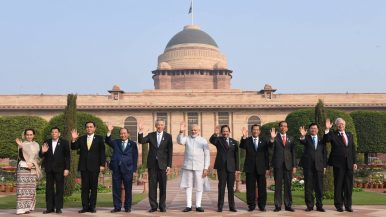By Rajeswari Pillai Rajagopalan
 India’s approach to Southeast Asia has been lately shifting from one dominated by trade and development to one in which strategic considerations play an important complementary role. This has taken a new form, and is now called the “Act East” Policy, marking also an expansion to include other Indo-Pacific countries. But there are some doubts about whether the ASEAN countries are entirely comfortable with the idea of the “Indo-Pacific.” Several ASEAN states have been lukewarm to the idea, worried about having to take sides between the United States and China. This raises questions about the viability of India’s new “ASEAN-centric” approach to the Indo-Pacific.
India’s approach to Southeast Asia has been lately shifting from one dominated by trade and development to one in which strategic considerations play an important complementary role. This has taken a new form, and is now called the “Act East” Policy, marking also an expansion to include other Indo-Pacific countries. But there are some doubts about whether the ASEAN countries are entirely comfortable with the idea of the “Indo-Pacific.” Several ASEAN states have been lukewarm to the idea, worried about having to take sides between the United States and China. This raises questions about the viability of India’s new “ASEAN-centric” approach to the Indo-Pacific.
ASEAN’s weaknesses in managing China is becoming more evident every day. While its success in regional economic integration is undeniable, on more fractious political issues, ASEAN was always less effective. These divisions have become far deeper when it comes to China. It is not clear that ASEAN will be able to act in a united manner when it comes to the South China Sea or on matters relating to China.
Smaller ASEAN countries are still wary of inviting China’s wrath by an open embrace of the Indo-Pacific concept. This is, paradoxically, a consequence of ASEAN’s success in integrating economically with China, making it hard for these countries to break with Beijing. This is particularly so for smaller countries like Cambodia, though several bigger players like Malaysia and Singapore have been resistant as wel. ASEAN, therefore, is a divided house.
New Delhi has no good options to deal with this problem. It is probably this recognition that has led India to stress additional platforms like the Bay of Bengal Initiative for Multi-Sectoral Technical and Economic Cooperation (BIMSTEC) which includes Bangladesh, India, Myanmar, Sri Lanka, Thailand, Bhutan, and Nepal.
There has also been some suggestion from experts that BIMSTEC could be expanded to include countries such as Indonesia. On the other hand, BIMSTEC has also so far been less than a grand success. Though India has recently attempted to revive BIMSTEC – partly to sideline the South Asian Association for Regional Cooperation (SAARC), which includes Pakistan – New Delhi’s efforts have sometimes fallen flat. An effort to expand the scope of BIMSTEC by conducting its first-ever military exercise saw two countries, Nepal and Thailand, refusing to join.
India and other countries are also stepping up efforts to chip away at one source of ASEAN’s dependence on China – infrastructural aid. India and Japan, along with the United States, have already started doing this. The private sector in India and Japan are also joining the United States under the Indo-Pacific Business Forum to promote infrastructure.
Such measures would provide real choices to countries in ASEAN and elsewhere in the Indo-Pacific that are otherwise stuck with China. India and its partners have had some success in pointing out the flaws in China’s model of infrastructure “aid,” which has at times led to debt traps that forced countries to give up valuable assets to China. This new form of neocolonialism is now well recognized. But without alternatives, the temptations of China’s checkbook diplomacy are hard to resist for many smaller countries. Thus, infrastructural assistance has to be an integral part of any strategy to counter China’s efforts in this direction.
The downside here is that India does not enjoy a very good track record in this regard. Despite the rhetoric of a strengthened outreach, the capacity to extend regional connectivity and infrastructure building has been insufficient. The Modi government too appears to have laid more emphasis in its official statements, with very little to show on the ground. The trilateral highway with Myanmar and Thailand is a case in point: though Thailand has completed its part of the highway, India has yet to do so on the Indian side of the border.
India’s poor track record in its infrastructure building in India’s Northeast is yet another indicator. If India cannot develop even its own connectivity with ASEAN, its pledges to help others in ASEAN with infrastructure are bound to sound hollow. India needs to do more to convert its rhetoric into reality.
India clearly wants to help ASEAN stand up to China because it is in New Delhi’s interest. But while there is little doubt about New Delhi’s desires, ASEAN countries are likely to look for actual deliveries rather than promises. India’s repeated assertion of ASEAN-centrality has so far not given ASEAN countries – especially the smaller ones – sufficient reason to hope that India can be an effective substitute for China. This will only deepen the existing divisions within ASEAN and make India’s ASEAN-centrality strategy that much more difficult to accomplish.
No comments:
Post a Comment